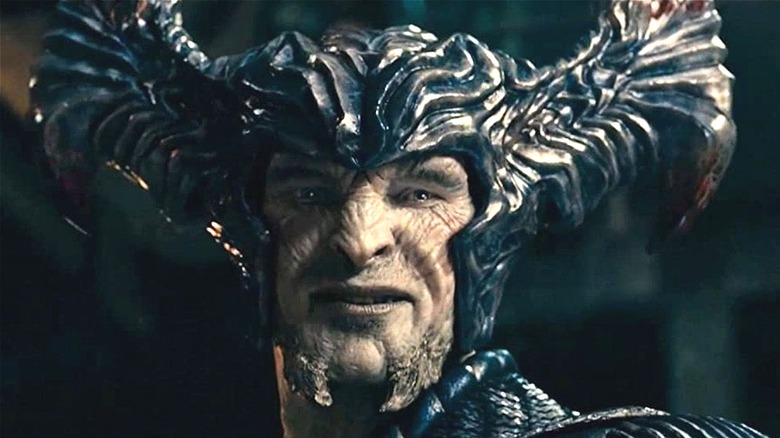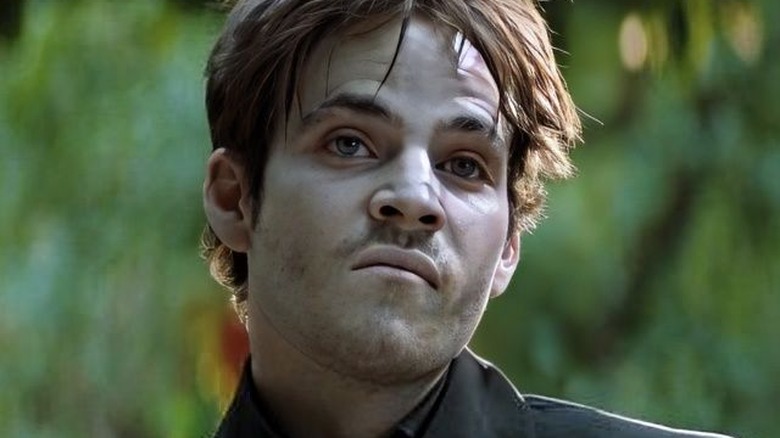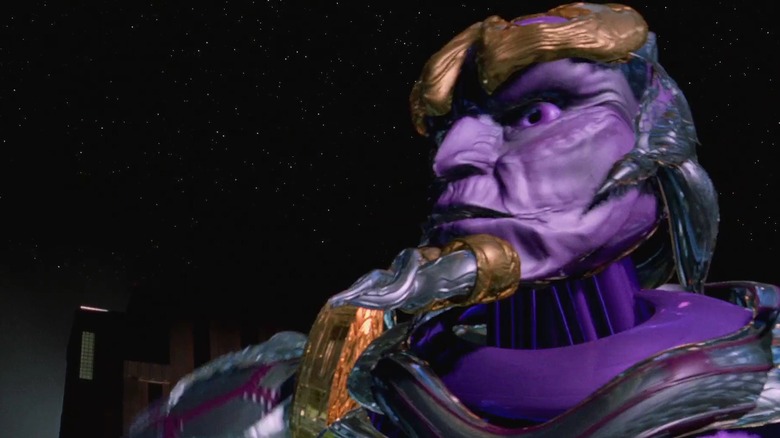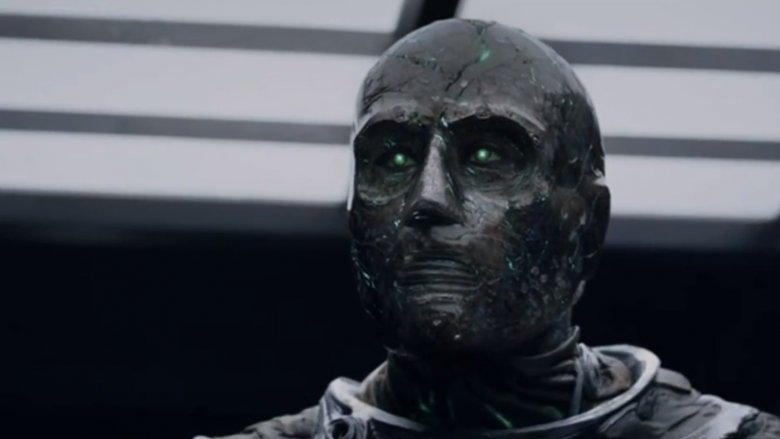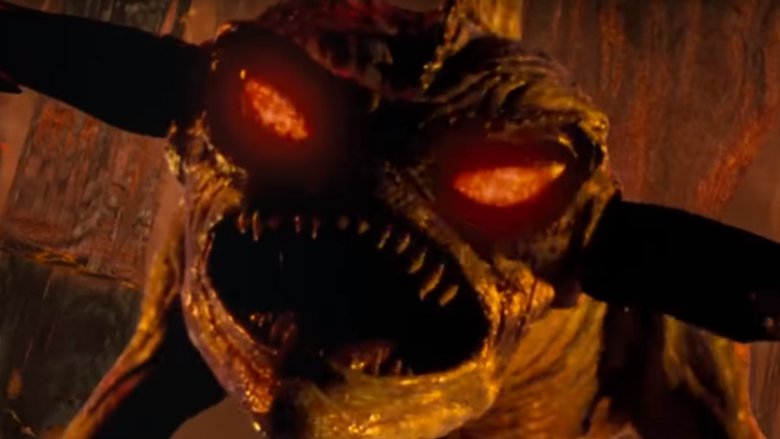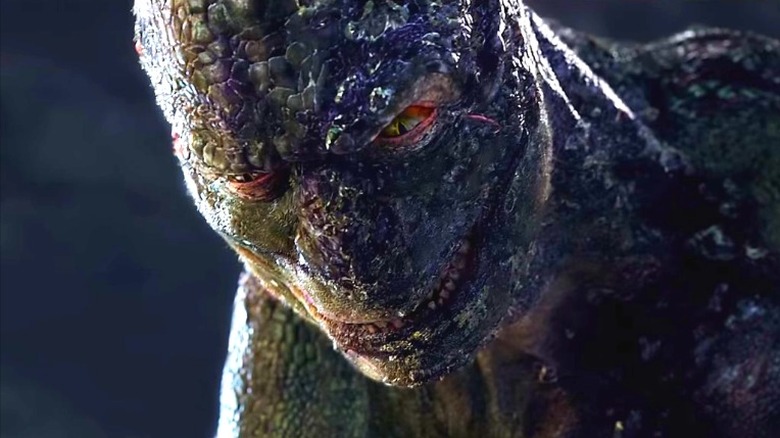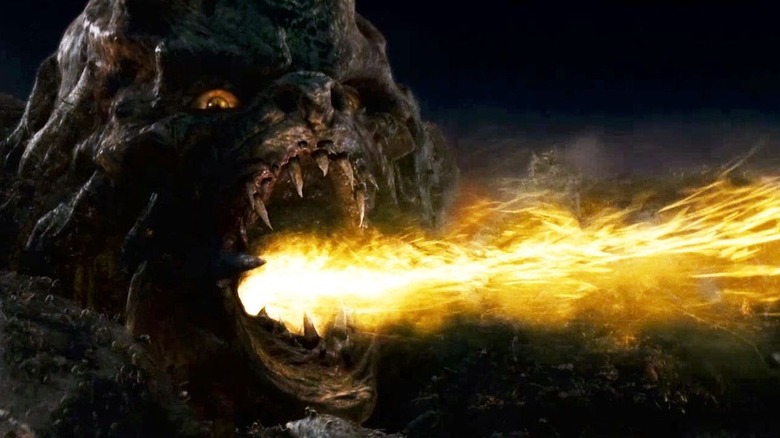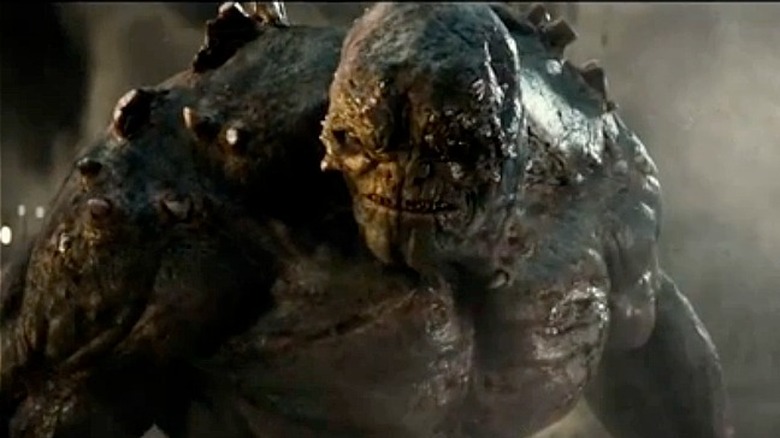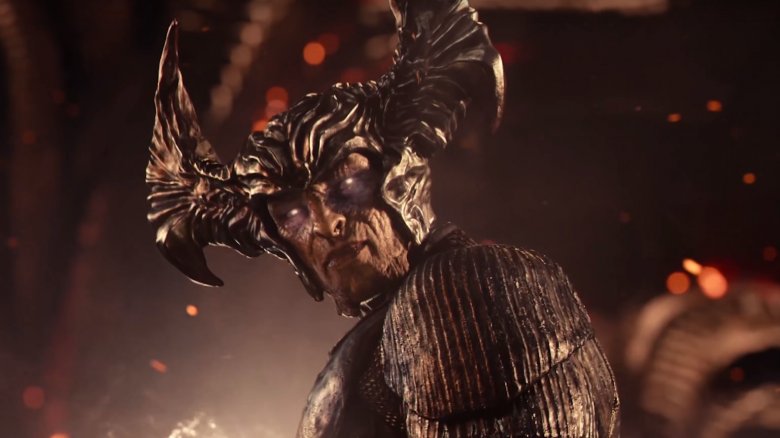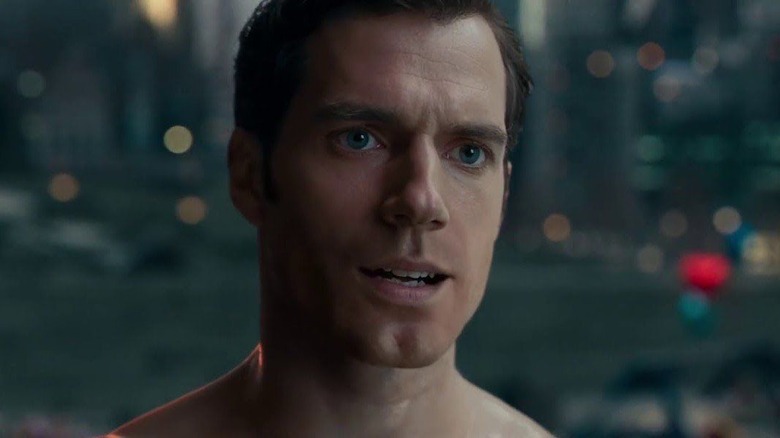Movie Supervillains That Were Ruined By Botched CGI
In a lot of ways, CGI is the greatest supervillain of all. Despite noble beginnings, it's powerful, it's often too ambitious, and it frequently seems bent on destroying everything that you love.
CGI has been a divisive addition to the cinematic landscape ever since it first popped up in 1973's Westworld (yes, children, there was another Westworld — you'd know this if you put down your phones and watched a VHS once in a while). Utilized properly, even in its nascent state, it has created some of the most iconic villains of all time. When used incorrectly, it gives us Gungans and that night terror Jeff Bridges from Tron Legacy.
This sad truth is on full display all too often when you go to a superhero movie. Try as studios might, it's no easy task to translate a great comic book monster to the big screen, and for every digital masterpiece like 2018's Thanos, there are five or six of, well, these guys.
Deacon Frost - Blade
1998's Blade was a ballsy movie to make. It broke ground that a lot of people may have forgotten about twenty years later. It was the first big budget R-rated superhero movie and the first mainstream comic book adaptation with an African American lead. It opened the door to future Marvel movies and, by most accounts, directly contributed to Wesley Snipes going a little bit totally bananas.
The film's chief antagonist: Stephen Dorff's Deacon Frost, the undead equivalent of a Hot Topic and an American Apparel having a kid that winds up at a school for troubled boys. For most of the movie, he's just a dude. Then that final battle starts and everything gets...unfortunate. During the fight scene, Blade cuts off Frost's arm, which would normally at least lead to a time out. Not for this vampire, though. Frost regenerates his lost limb thanks to blood magic, which happens to look a lot like something from a cutscene in a PlayStation 2 game.
Bonus fact: in the original cut, there was a much worse scene involving Frost turning into a blood tornado. It's totally worth watching if you want to go blind.
Ivan Ooze - Mighty Morphin Power Rangers: The Movie
The Power Rangers meant a lot to the Millennial generation. What couldn't they do? They were mighty. They could morph. They could, with proper verbal provocation, go go. Wrapped in color coded, action figure-ready uniforms and sprinkled with a metric ton of teamwork making the dream work, they would easily have been the most rock and roll superhero team of the 90's, if it wasn't for the X-Men and that theme song that so many of us still have stuck in our heads.
In 1995, millions of children's dreams came true when Mighty Morphin Power Rangers: The Movie took the regular 21-minute format of the Power Rangers TV show and expanded it to a mind blowing 95-minute extravaganza, giving parents around the world nearly five times as long to drink wine and cry in their rooms while their kids watched television. The bad guy, Ivan Ooze, was a top notch combination of bad puns, latex prosthetics, and purple Gak. Then along comes the final boss fight, and Ooze turns into what would best be described as the rough draft of a storyboard for an episode of Beast Wars.
Doctor Doom - Fantastic Four
Back in 2005 (hear us out), the Fantastic Four movie (stay with us) starring Jessica Alba (don't ditch us now) was widely considered (we're in the home stretch) bad. Maybe it was the vanilla storyline or the departures from the source material, or maybe pre-MCU audiences just weren't ready for it. It was mostly those first two things.
But then, a ray of hope. 2015 promised that most cathartic of nerd redemptions: a gritty reboot. Chronicle's Josh Trank was announced as the director of a new generation of Fantastic Four movies, the first (and, it would turn out, only) of which was advertised as Fant4stic (we can only assume it's pronounced how it's spelled). Fans hoped for a worthy take on Marvel's first family, as well as their nemesis, Doctor Victor Von Doom, who many felt got the shaft during the mid-2000's movies. What they got was an objective drag where Doom looked like the second least expensive decorative lamp at a Spencer's Gifts.
Just about everyone - Spawn
Spawn's faded from public consciousness a little bit in the last few years, but he was a perfect antihero for the '90s. He was dark and edgy. He was Spider-Man meets Ghost Rider. He was, if we're being perfectly honest, maybe too much to reasonably expect on a $45 million movie budget.
In the months leading up to Spawn's release, an enormous amount of attention was given to the film's ambitious use of CGI to recreate Todd McFarlane's signature over-the-top comic book visuals. And you know what? Ambitious is exactly what those visuals were. And that's about the nicest thing you can say about them.
Whether the movie was giving John Leguizamo visible farts or showing off the title character's unearthly seventy foot cape, the effects hold up about as well as a Capri Sun commercial. Especially rough, though, were the shots of The Devil himself, who looks dangerously close to a background character in one of the 90's era Dungeon Keeper games.
Lizard - The Amazing Spider-Man
The Lizard was one of those classic Spider-Man characters that fans of the comics had long been waiting to see. Sam Raimi first started hinting at him in Spider-Man 2, way back when there were few enough Spiders-Men that you didn't need a subtitle or an adjective to differentiate them. First appearing on comic pages in Amazing Spider-Man #6 way back in 1963, Lizard is an archetypal Spidey villain: good intentions, bad science, and a tragic origin story that led to a life of animal cosplay.
Lizard's look has varied wildly since his inception, running the gamut from "big gecko in a lab coat" to "big alligator in a lab coat." The incarnation seen in the 2012 Amazing Spider-Man movie, however, drew less inspiration from the animal kingdom and more from the goombas in the Super Mario Bros. movie. Seriously, it's uncanny how much he wound up looking like one of those things. Even more damning was his plan to turn New York into a city of giant reptiles, essentially guaranteeing that everyone would walk the dinosaur.
Parallax - Green Lantern
You don't need us to tell you that Ryan Reynolds' Green Lantern wasn't a great movie. For that, you already have Ryan Reynolds. The characters are bland, the script is a drag, and a theoretically magnificent interstellar setting just kind of blows real hard. Even the character designs were weak, which is a pretty shocking failure when you've got decades of particularly trippy comic book artwork to draw from.
Case in point: Parallax, the movie's big bad. Parallax is the embodiment of fear, a yellow space monster bent on destruction. Even in the comics, he was always a nebulous collection of limbs and teeth, so it's easy to see why the filmmakers were eager to try and show off all of their CGI prowess bringing him to life. Unfortunately, the end result was a cross eyed, fanged Jell-O night terror the color of radioactive Dijon mustard. He looks like someone spilled coffee on the keyboard while animating an orc from Lord of the Rings.
Luckily, the DC Cinematic Universe was rebooted not long after Green Lantern's release, and they never made that mistake again.
Doomsday - Batman v Superman
Batman v Superman: Dawn of Saving Money By Leaving Out The "S" In "Vs" And Then Hiring A Poster Printer Who Charges By The Letter wasn't really anybody's idea of a good time. It started out as a quasi-adaptation of Frank Miller's The Dark Knight Returns (a story about Superman getting punched really hard), then subtly transitioned into a quasi-adaptation of The Death of Superman (a story about Superman getting punched even harder). And yet, somehow, these two great tastes didn't taste great together.
The sorta-surprise villain at the end of the movie is sorta-Doomsday, a remarkably 90's bad guy made of muscle and rocks and, occasionally, ponytails. His signature look is plenty iconic. Unfortunately, for his silver screen debut, the production team just made him look like Abomination from The Incredible Hulk with cystic acne. The dude is a gloopy mess.
Luckily, the DC Cinematic Universe had other, less established characters to experiment with visually, so they never made that mistake again...right?
Steppenwolf - Justice League
On paper, the idea of some of the world's most recognizable superheroes squaring off against a semi-demonic alien overlord sounds like a hard pitch to strike out on. Even better, said overlord was the creation of Jack Kirby, one of the most widely respected artists ever to work within the medium. Steppenwolf: New God, immortal warrior, fancy helmet enthusiast. He's a supervillain aficionado's absolute dream.
Then along comes the Justice League movie and shucks does he look like a pile of bad. Starting with the helmet (which looks like someone took all of the discarded Klingon headpieces off the set of Star Trek and melted them together in a Creepy Crawlers Workshop Oven), and moving down to his face (which is what would happen if Adobe After Effects had a "Generate Evil Monster" button), Steppenwolf just doesn't come together. He doesn't just live in the uncanny valley, he builds an apartment complex there and jacks up the rent so that nobody can live there but him. He looks like something Peter Jackson sneezed.
It would be nice to say DC never made that mistake again, but we're starting to learn our lesson here, aren't we? At least Steppenwolf looked marginally better in the Snyder Cut.
Superman's upper lip - Justice League
Sometimes, the real villain isn't the monster destroying the city. Sometimes, the real villain is mankind's inability to work together. And sometimes, that malignant attitude leads to newer, more terrible villains, like whatever the Lovecraftian horror on the bottom third of Superman's face is.
Like many of the internet movie reviewers it tried to woo, Justice League had a troubled childhood that led to some severe problems later in life. Over the course of production, it ran through two distinctly different directors. There was Zack Snyder, the cool dad with a motorcycle who lets you try his beer; and Joss Whedon, the goofy stepdad who reminds you that learning can be fun, too. When Snyder exited the project, Whedon took over and reshaped it, requiring massive reshoots.
By that point, though, Henry Cavill had already grown a mustache for his part in Mission: Impossible — Fallout. He could either shave it, making it a $20 fake mustache problem for Paramount, or leave it and make it a hundreds-of-thousands-of-dollars fake upper lip problem for DC. The rest is history, in that history is mostly an account of all the most horrifying things that have ever happened, i.e. Superman's digital fish meat of a mouth in that movie.
